The Operation Barbarossa, or Unternehmen Barbarossa, was the German codename for Nazi Germany’s invasion of the Soviet Union during World War II, which commenced on June 22, 1941.
Operation Barbarossa was the turning point of Adolf Hitler’s Third Reich. The Operation resulted in the eventual defeat of Nazis. Operation Barbarossa opened the Eastern Front would become the biggest theater of war in World War II. It was some of the largest and most brutal battles, terrible loss of life, and miserable conditions for both the Russians and the Germans.
A German infantryman walks toward the body of a killed Soviet soldier and a burning BT-7 light tank in the southern Soviet Union in in 1941, during the early days of Operation Barbarossa.
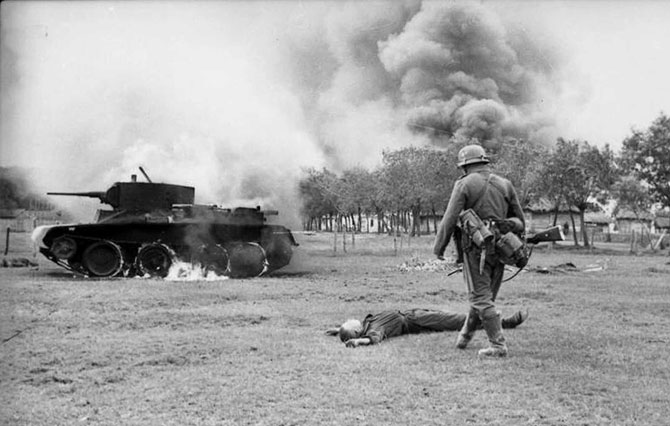
Photo credit: Deutsches Bundesarchiv / AP Photo / Text: Ian Carter
An Sd.Kfz-250 half-track in front of German tank units, as they prepare for an attack, on July 21, 1941, somewhere along the Russian warfront, during the German invasion of the Soviet Union.
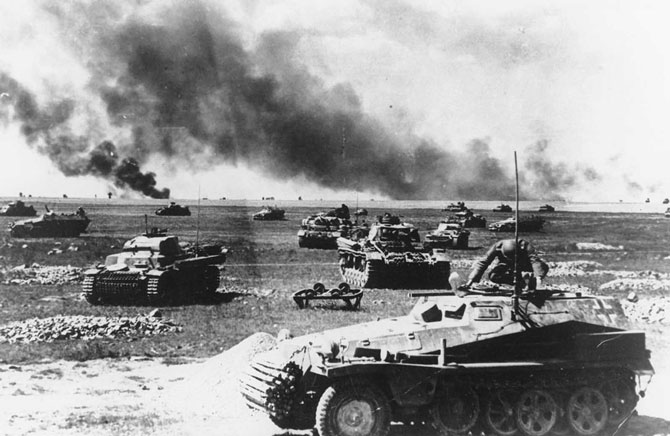
Photo credit: Deutsches Bundesarchiv / AP Photo / Text: Ian Carter
A German half-track driver inside an armored vehicle in Russia in August of 1941.
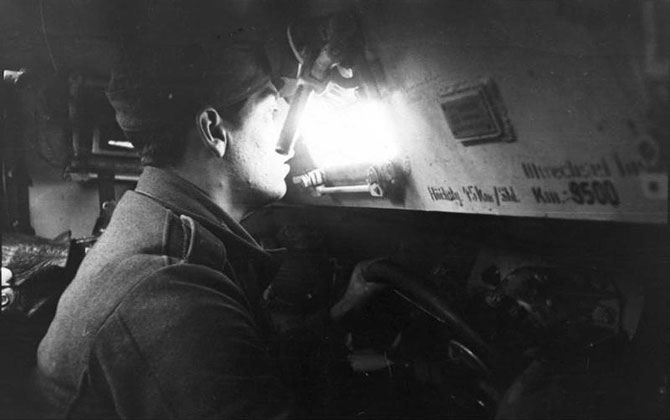
Photo credit: Deutsches Bundesarchiv / AP Photo / Text: Ian Carter
German infantrymen watch enemy movements from their trenches shortly before an advance inside Soviet territory, on July 10, 1941.
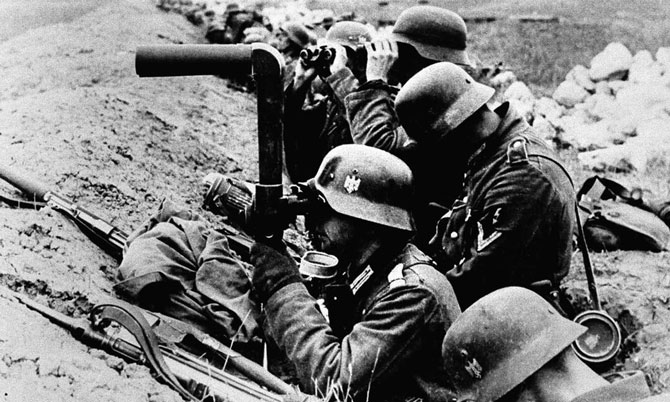
Photo credit: Deutsches Bundesarchiv / AP Photo / Text: Ian Carter
German Stuka dive-bombers, in flight heading towards their target over coastal territory between Dniepr and Crimea, towards the Gate of the Crimea on November 6, 1941.
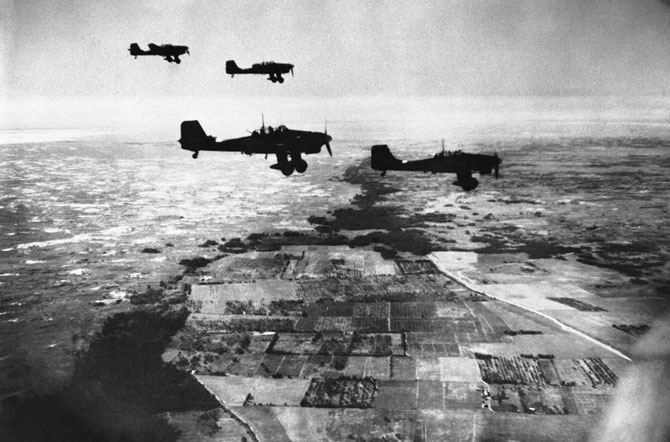
Photo credit: Deutsches Bundesarchiv / AP Photo / Text: Ian Carter
German soldiers cross a river, identified as the Don river, in a stormboat, sometime in 1941, during the German invasion of the Caucasus region in the Soviet Union.
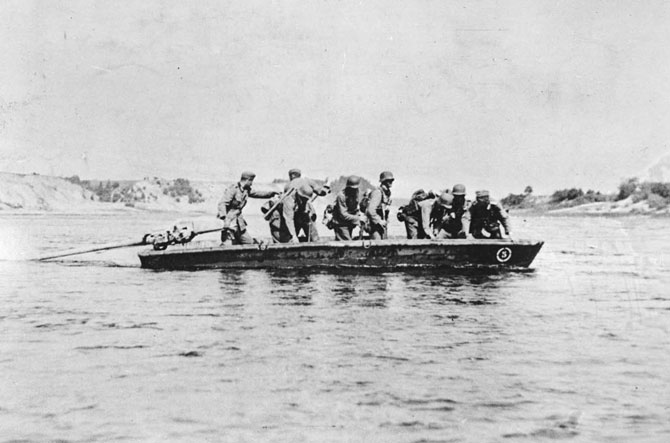
Photo credit: Deutsches Bundesarchiv / AP Photo / Text: Ian Carter
German soldiers move a horse-drawn vehicle over a corduroy road while crossing a wetland area, in October 1941, near Salla on Kola Peninsula, a Soviet-occupied region in northeast Finland.
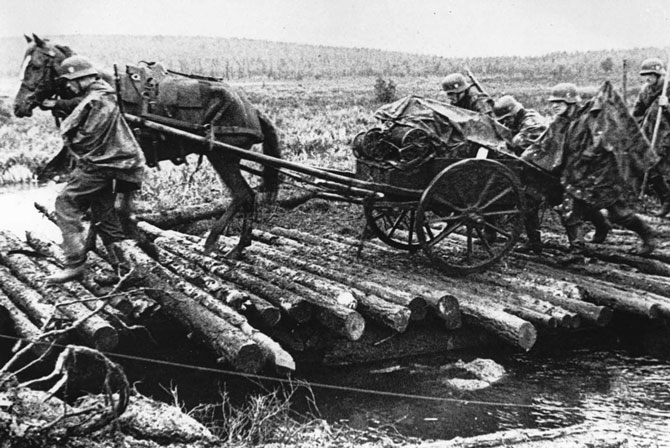
Photo credit: Deutsches Bundesarchiv / AP Photo / Text: Ian Carter
With a burning bridge across the Dnieper river in the background, a German sentry keeps watch in the recently-captured city of Kiev, in 1941
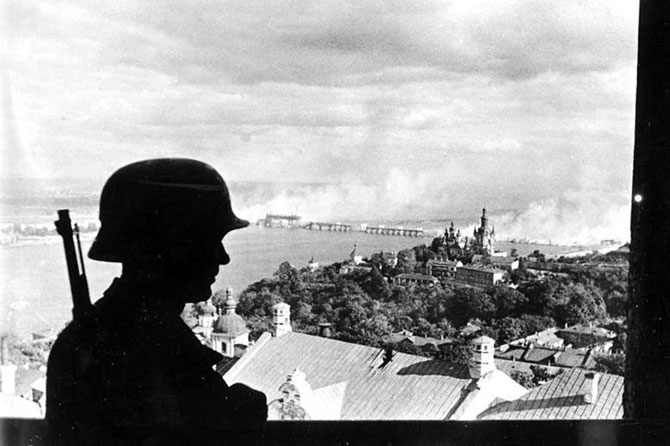
Photo credit: Deutsches Bundesarchiv / AP Photo / Text: Ian Carter
Machine gunners of the far eastern Red Army in the USSR, during the German invasion of 1941.
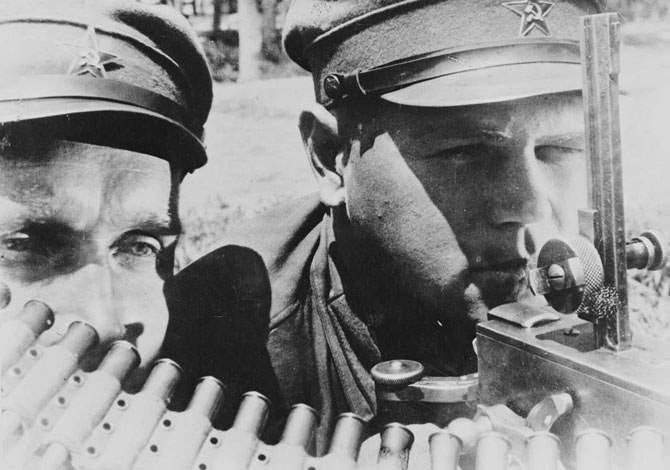
Photo credit: Deutsches Bundesarchiv / AP Photo / Text: Ian Carter
A German bomber, with its starboard engine on fire, goes down over an unknown location, during World War II, in November, 1941.
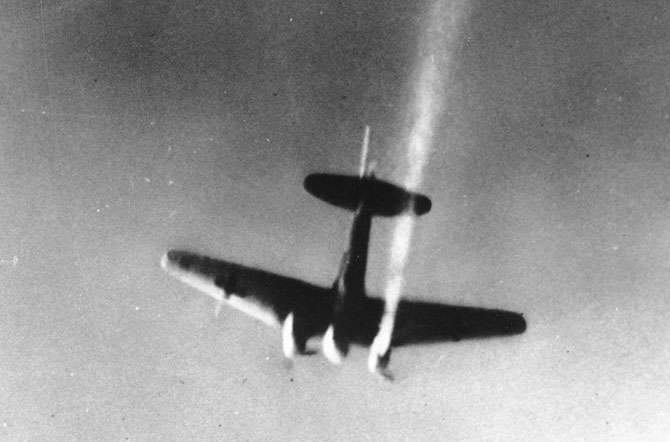
Photo credit: Deutsches Bundesarchiv / AP Photo / Text: Ian Carter
Nazi troops lie concealed in the undergrowth during the fighting prior to the capture of Kiev, Ukraine, in 1941.
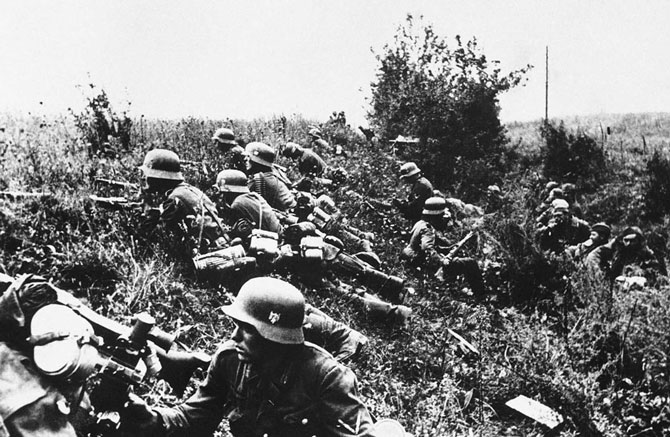
Photo credit: Deutsches Bundesarchiv / AP Photo / Text: Ian Carter
Evidence of Soviet resistance in the streets of Rostov, a scene in late 1941, encountered by the Germans as they entered the heavily besieged city.
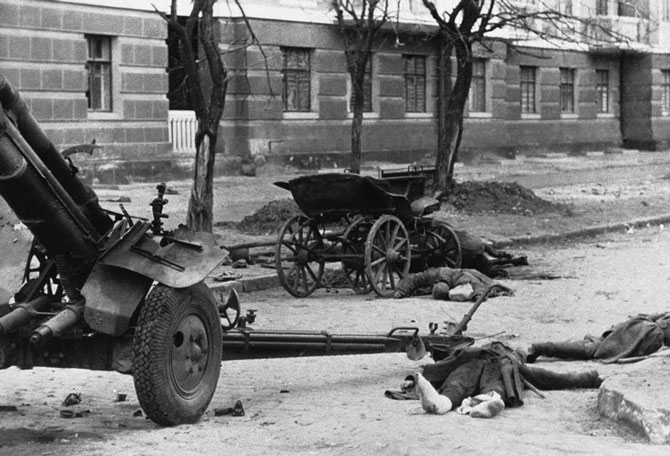
Photo credit: Deutsches Bundesarchiv / AP Photo / Text: Ian Carter
Russian soldiers, left, hands clasped to heads, marched back to the rear of the German lines on July 2, 1941, as a column of Nazi troops move up to the front at the start of hostilities between Germany and Russia.
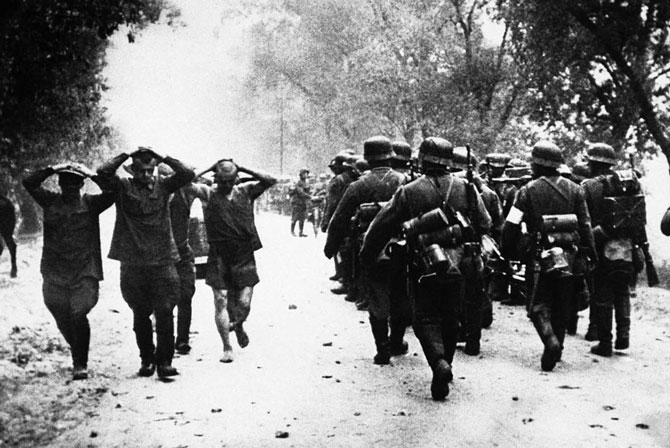
Photo credit: Deutsches Bundesarchiv / AP Photo / Text: Ian Carter
Russian men and women rescue their humble belongings from their burning homes, said to have been set on fire by the Russians, part of a scorched-earth policy, in a Leningrad suburb on October 21, 1941.
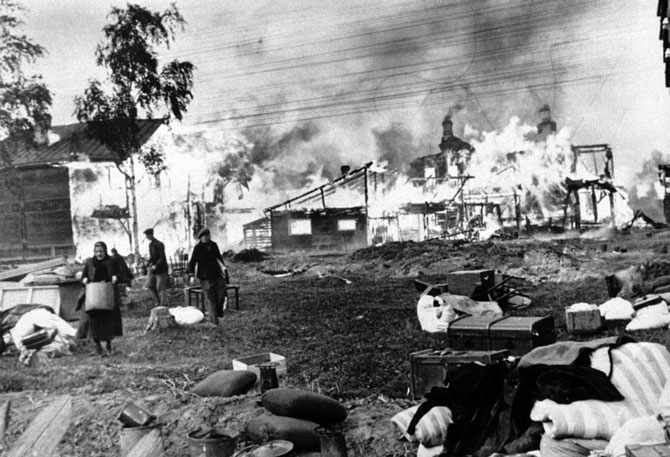
Photo credit: Deutsches Bundesarchiv / AP Photo / Text: Ian Carter
Reindeer graze on an airfield in Finland on July 26, 1941. In the background a German war plane takes off.
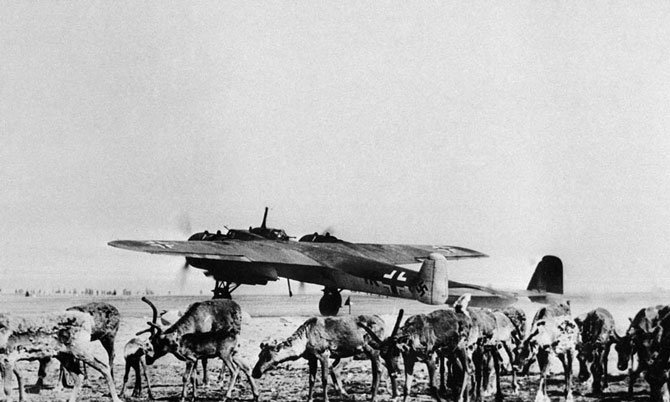
Photo credit: Deutsches Bundesarchiv / AP Photo / Text: Ian Carter
Heinrich Himmler (left, in glasses), head of the Gestapo and the Waffen-SS, inspects a prisoner-of-war camp in this from 1940-41 in Russia.
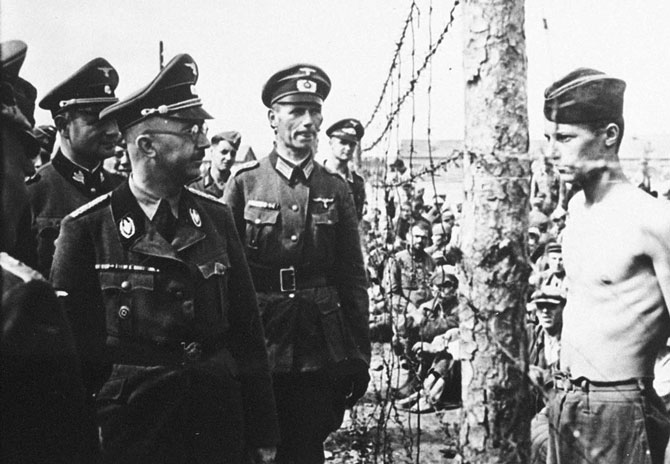
Photo credit: Deutsches Bundesarchiv / AP Photo / Text: Ian Carter
Evidence of the fierce fighting on the Moscow sector of the front is provided in this photo showing what the Germans claim to be some of the 650,000 Russian prisoners which they captured at Bryansk and Vyasma. They are here seen waiting to be transported to a prisoner of war camp somewhere in Russia, on November 2, 1941.
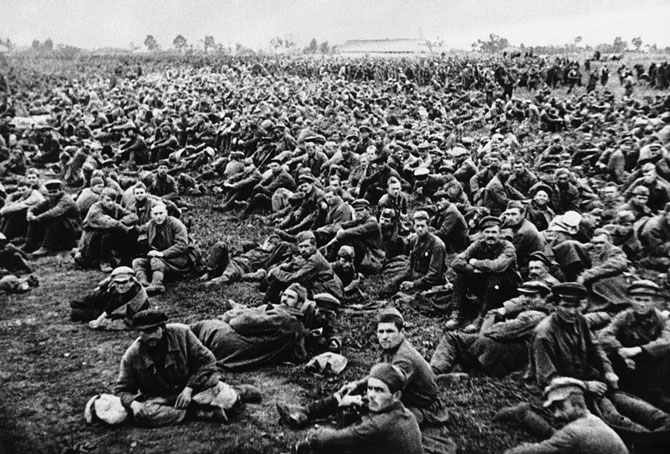
Photo credit: Deutsches Bundesarchiv / AP Photo / Text: Ian Carter
Adolf Hitler, center, studies a Russian war map with General Field Marshal Walter Von Brauchitsch, left, German commander in chief, and Chief of Staff Col. General Franz Halder, on August 7, 1941.
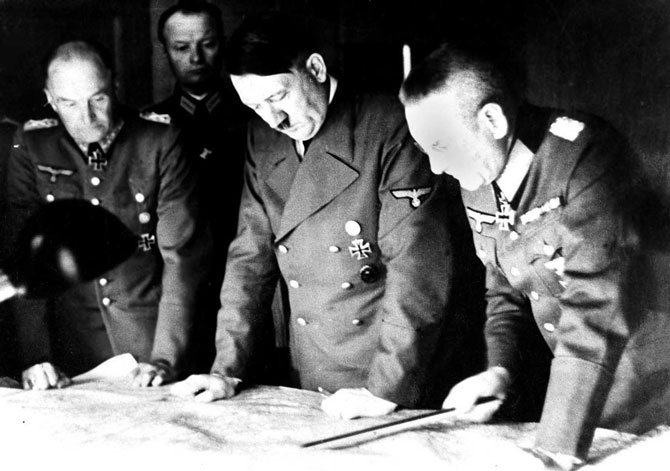
Photo credit: Deutsches Bundesarchiv / AP Photo / Text: Ian Carter
German soldiers, supported by armored personnel carriers, move into a burning Russian village at an unknown location during the German invasion of the Soviet Union, on June 26, 1941.
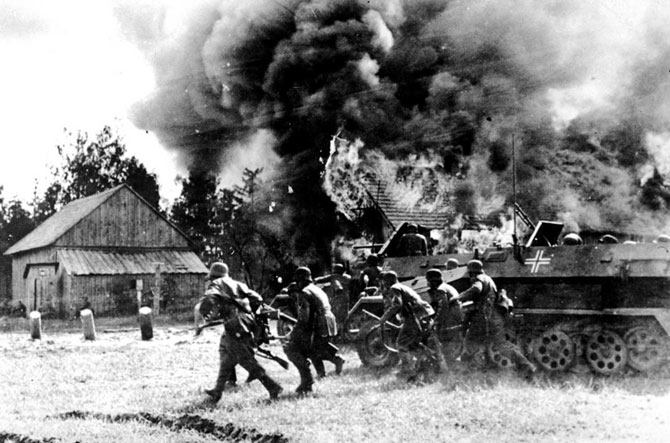
Photo credit: Deutsches Bundesarchiv / AP Photo / Text: Ian Carter
A huge Russian gun on tracks, likely a 203 mm howitzer M1931, is manned by its crew in a well-concealed position on the Russian front on September 15, 1941.
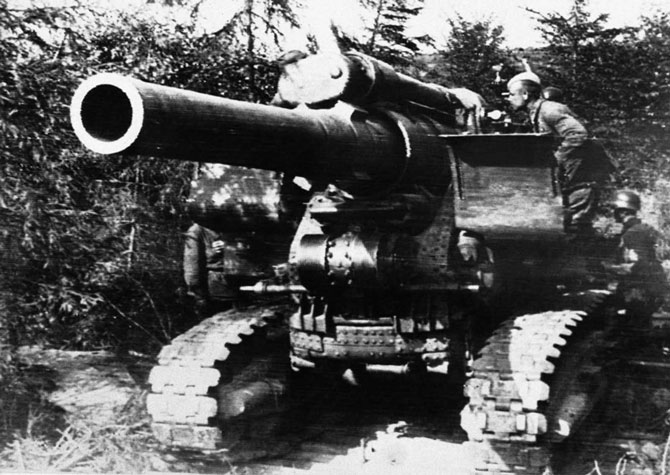
Photo credit: Deutsches Bundesarchiv / AP Photo / Text: Ian Carter
Rapidly advancing German forces encountered serious guerrilla resistance behind their front lines. Here, four guerrillas with fixed bayonets and a small machine gun are seen in action, near a small village.
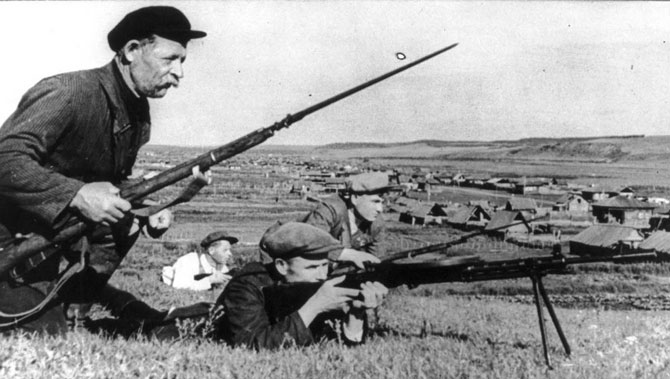
Photo credit: Deutsches Bundesarchiv / AP Photo / Text: Ian Carter
Red Army soldiers examine war trophies captured in battles with invading Germans, somewhere in Russia, on September 19, 1941.
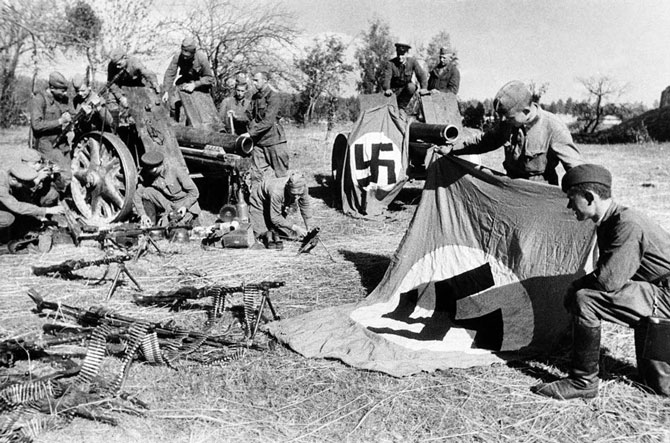
Photo credit: Deutsches Bundesarchiv / AP Photo / Text: Ian Carter
A view of the destruction in Riga, the capital of Latvia, on October 3, 1941, after the wave of war had passed over it, the Russians had withdrawn and it was in Nazi hands.
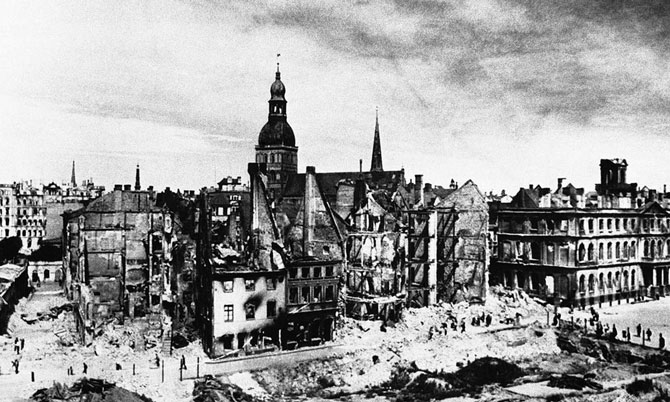
Photo credit: Deutsches Bundesarchiv / AP Photo / Text: Ian Carter
Five Soviet civilians on a platform, with nooses around their necks, about to be hanged by German soldiers, near the town of Velizh in the Smolensk region, in September of 1941.
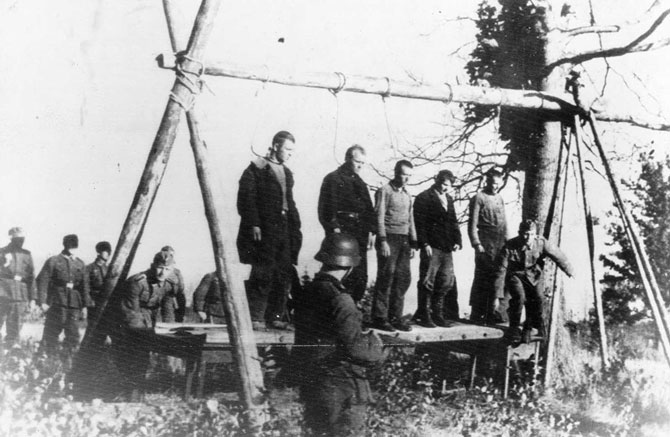
Photo credit: Deutsches Bundesarchiv / AP Photo / Text: Ian Carter
A Finnish troop train passes through a scene of an earlier explosion which wrecked one train, tearing up the rails and embankment, on October 19, 1941.
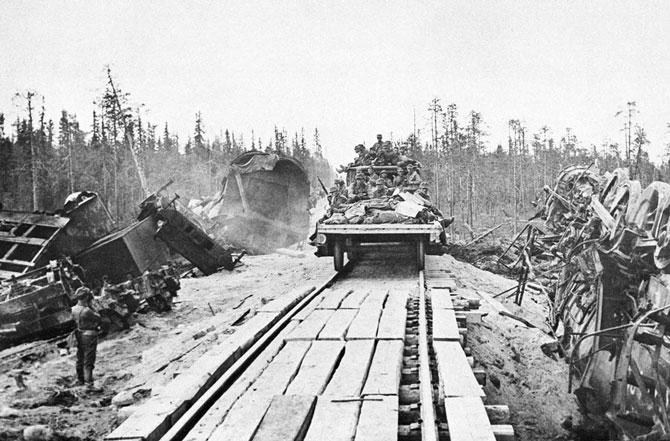
Photo credit: Deutsches Bundesarchiv / AP Photo / Text: Ian Carter
Burning houses, ruins and wrecks speak for the ferocity of the battle preceding this moment when German forces entered the stubbornly defended industrial center of Rostov on the lower Don River, in Russia, on November 22, 1941.
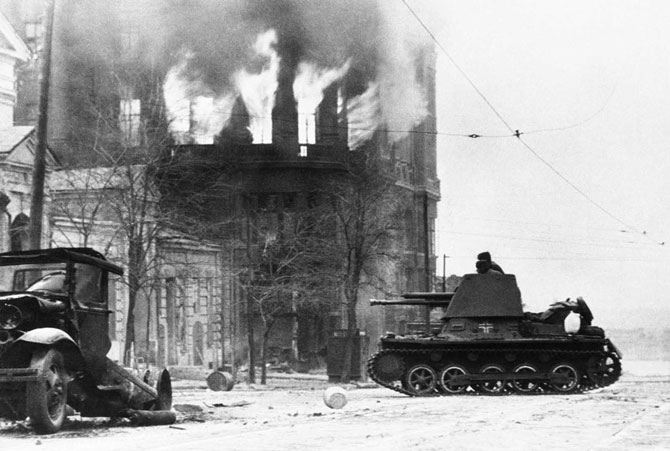
Photo credit: Deutsches Bundesarchiv / AP Photo / Text: Ian Carter
General Heinz Guderian, commander of Germany’s Panzergruppe 2, chats with members of a tank crew on the Russian front, on September 3, 1941.
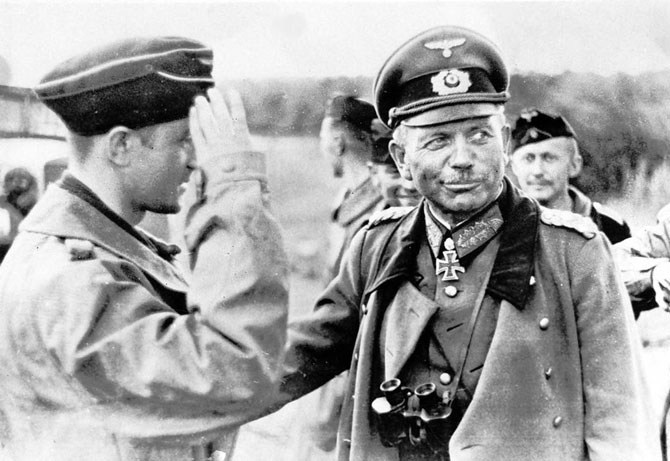
Photo credit: Deutsches Bundesarchiv / AP Photo / Text: Ian Carter
German soldiers remove one of many Soviet national emblems during their drive to conquer Russia on July 18, 1941.
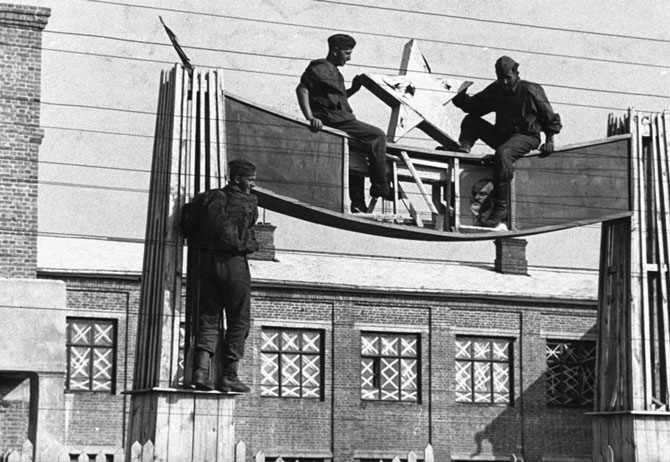
Photo credit: Deutsches Bundesarchiv / AP Photo / Text: Ian Carter
A man, his wife, and child are seen after they had left Minsk on August 9, 1941, when the German army swarmed in. The original wartime caption reads, in part: “Hatred for the Nazis burns in the man’s eyes as he holds his little child, while his wife, completely exhausted, lies on the pavement”.
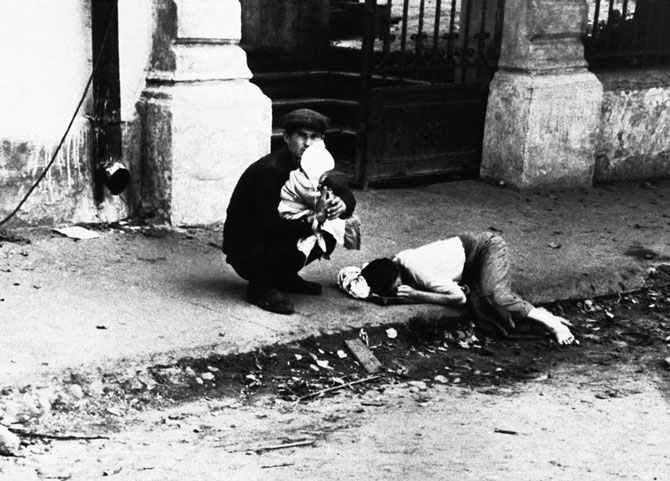
Photo credit: Deutsches Bundesarchiv / AP Photo / Text: Ian Carter
German officials claimed that this photo was a long-distance camera view of Leningrad, taken from the Germans’ seige lines, on October 1, 1941, the dark shapes in the sky were identified as Soviet aircraft on patrol, but were more likely barrage balloons. This would mark the furthest advance into the city for the Germans, who laid seige to Leningrad for more than two more years, but were unable to fully capture the city.
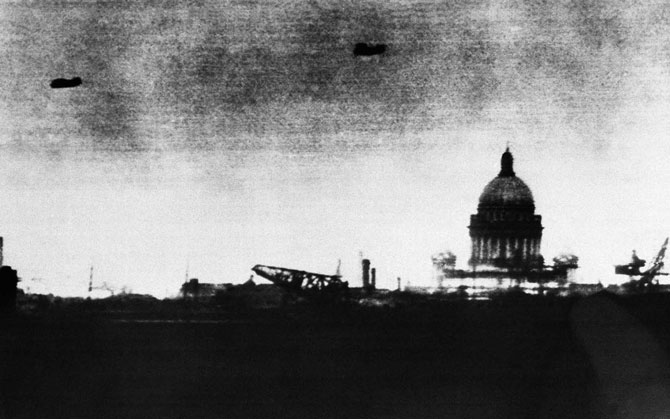
Photo credit: Deutsches Bundesarchiv / AP Photo / Text: Ian Carter
A flood of Russian armored cars move toward the front, on October 19, 1941.
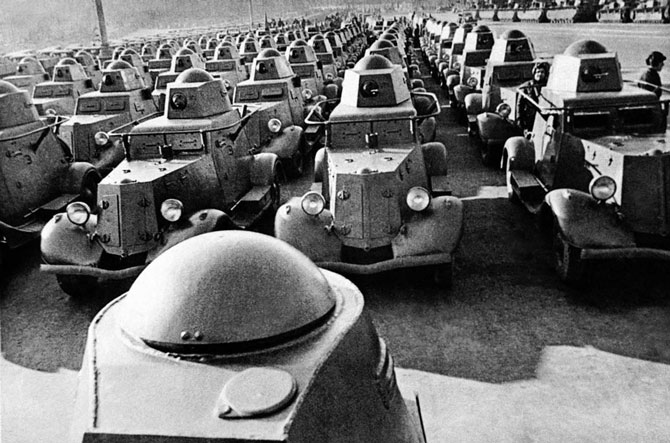
Photo credit: Deutsches Bundesarchiv / AP Photo / Text: Ian Carter
German Army Commander Colonel General Ernst Busch inspects an anti-aircraft gun position, somewhere in Germany, on Sept. 3, 1941.
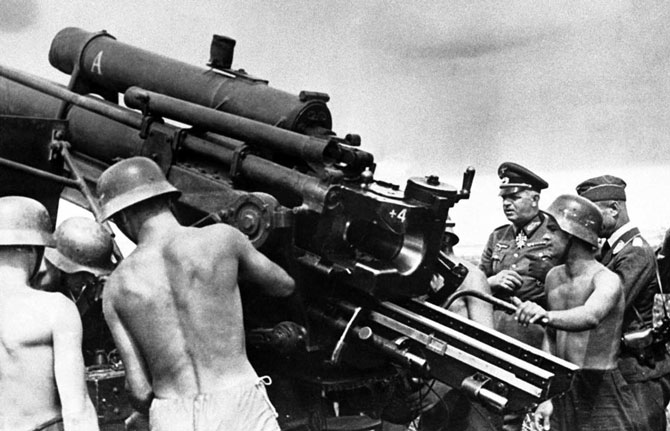
Photo credit: Deutsches Bundesarchiv / AP Photo / Text: Ian Carter
Finnish soldiers storm a soviet bunker on August 10, 1941. One of the Soviet bunker’s crew surrenders, left.
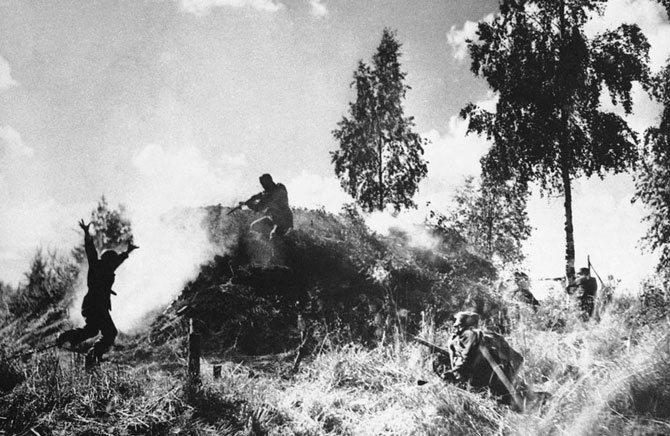
Photo credit: Deutsches Bundesarchiv / AP Photo / Text: Ian Carter
German troops make a hasty advance through a blazing Leningrad suburb, in Russia on November 24, 1941.
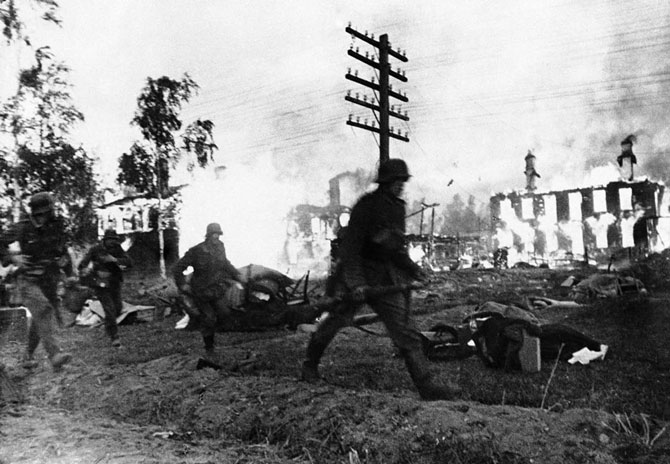
Photo credit: Deutsches Bundesarchiv / AP Photo / Text: Ian Carter
Russian prisoners of war, taken by the Germans on July 7, 1941.
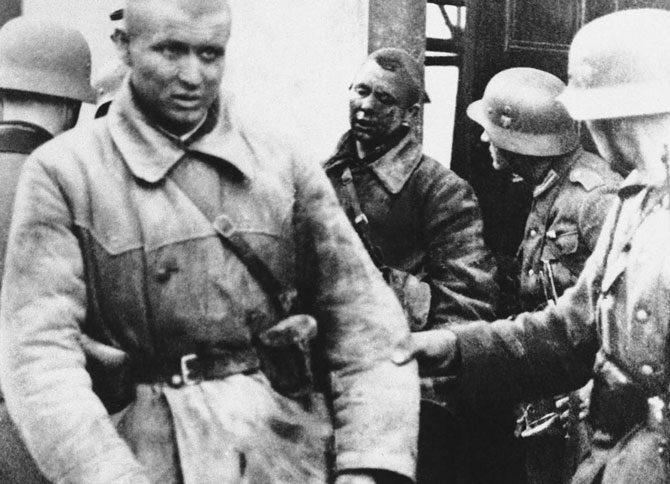
Photo credit: Deutsches Bundesarchiv / AP Photo / Text: Ian Carter
An column of Russian prisoners of war taken during recent fighting in Ukraine, on their way to a Nazi prison camp on September 3, 1941.

Photo credit: Deutsches Bundesarchiv / AP Photo / Text: Ian Carter
German mechanized troops rest at Stariza, Russia on November 21, 1941, only just evacuated by the Russians, before continuing the fight for Kiev. The gutted buildings in the background testify to the thoroughness of the Russians “scorched earth” policy.
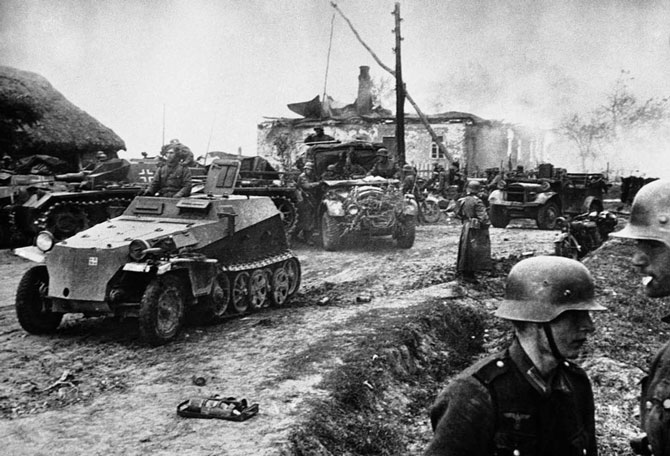
Photo credit: Deutsches Bundesarchiv / AP Photo / Text: Ian Carter
German infantrymen force their way into a snipers hide-out, where Russians had been firing upon advancing German troops, on September 1, 1941.
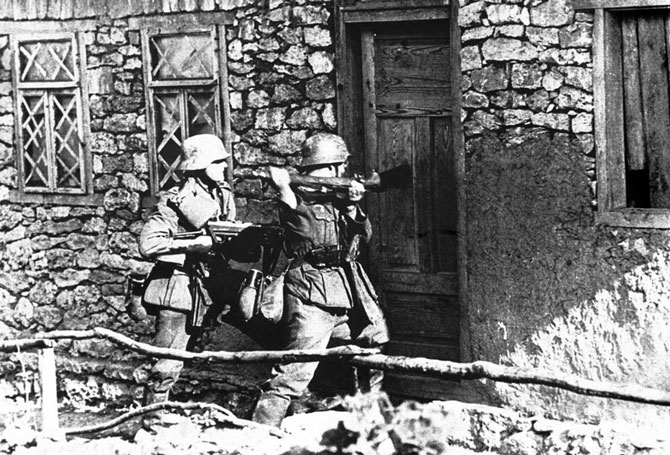
Photo credit: Deutsches Bundesarchiv / AP Photo / Text: Ian Carter
Two Russian soldiers, now prisoners of war, inspect a giant statue of Lenin, somewhere in Russia, torn from its pedestal and smashed by the Germans in their advance, on August 9, 1941. Note the rope round the neck of the statue, left there in symbolic fashion by the Germans.
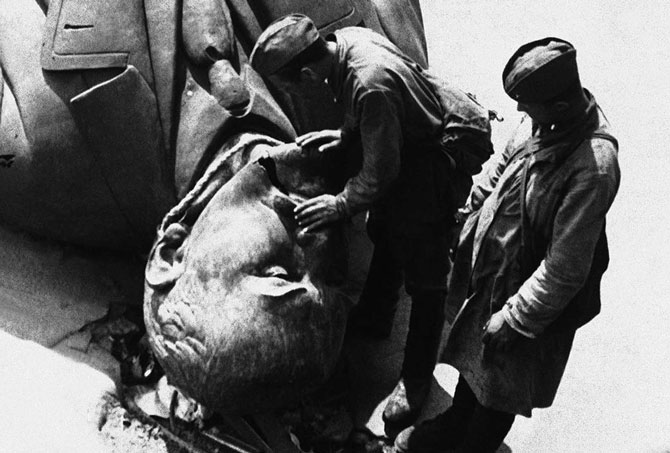
Photo credit: Deutsches Bundesarchiv / AP Photo / Text: Ian Carter
German sources described the gloomy looking officer at the right as a captured Russian colonel who is being interrogated by Nazi officers on October 24, 1941.
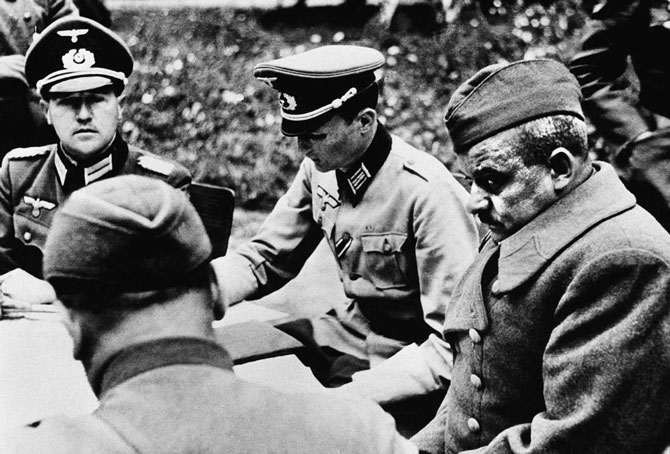
Photo credit: Deutsches Bundesarchiv / AP Photo / Text: Ian Carter
Flames shoot high from burning buildings in the background as German troops enter the city of Smolensk, in the central Soviet Union, during their offensive drive onto the capital Moscow, in August of 1941.
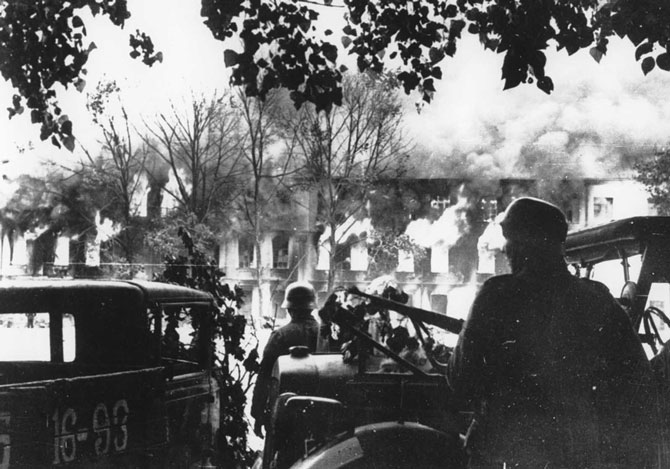
Photo credit: Deutsches Bundesarchiv / AP Photo / Text: Ian Carter
This trainload of men was described by German sources as Soviet prisoners en route to Germany, on October 3, 1941. Several million Soviet soldiers were eventually sent to German prison camps, the majority of whom never returned alive.
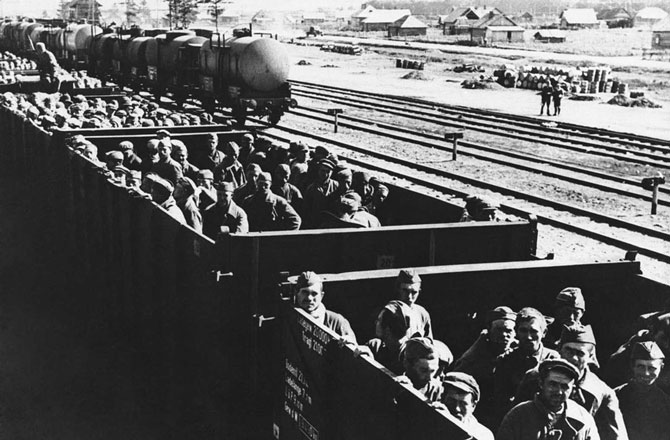
Photo credit: Deutsches Bundesarchiv / AP Photo / Text: Ian Carter
Russian snipers leave their hide-out in a wheat field, somewhere in Russia, on August 27, 1941, watched by German soldiers. In foreground is a disabled soviet tank.
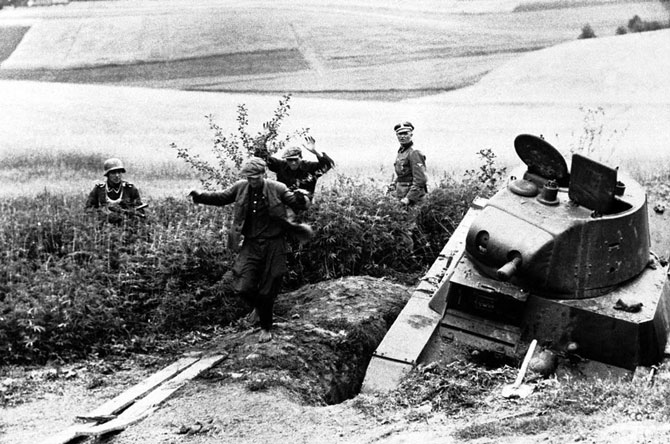
Photo credit: Deutsches Bundesarchiv / AP Photo / Text: Ian Carter
German infantrymen in heavy winter gear march next to horse-drawn vehicles as they pass through a district near Moscow, in November 1941. Winter conditions strained an already thin supply line, and forced Germany to halt its advance – leaving soldiers exposed to the elements and Soviet counterattacks, resulting in heavy casualties and a serious loss of momentum in the war.
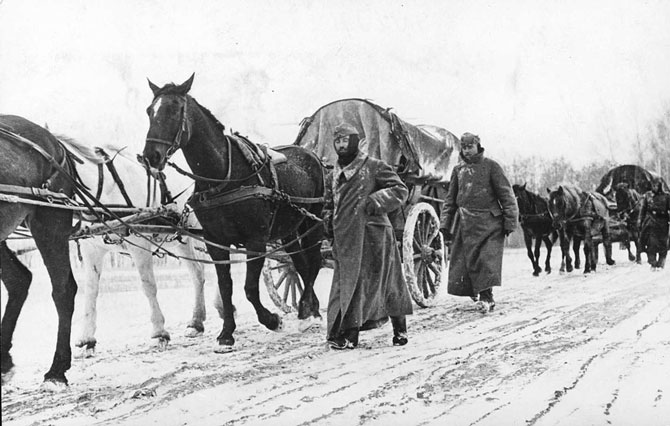
Photo credit: Deutsches Bundesarchiv / AP Photo / Text: Ian Carter
